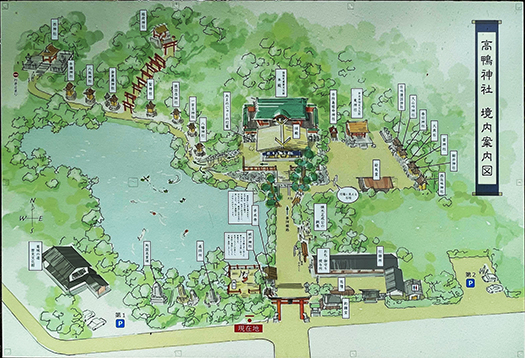

先日の関西〜信州飯田往復の旅の最終日、結局、帰りは奈良県の橿原に宿泊して前述のように「重要伝統的建造物群保存地区」のなかの旅宿で体を休めていた。
翌日、札幌に帰還するのだけれど、レンタカー道中でもあり、やはり大和盆地のなかでいまや「郷愁」を感じている飛鳥大仏と、もう1箇所、高鴨神社に詣でることにした。明日香から適当にクルマを走らせていたら、途中からはなにかが導いてくれているように、よんどころなく高鴨神社に到着することが出来た。きっと数寄のこころが体内で喜び勇んで、こここっち、そこはこっちとわたしのハンドル捌きを教習してくれているかのようだった(笑)。
たぶんはじめて訪れてからは4度目くらいの訪問・参詣。
以下は、神域手前に建てられた案内掲示からの要旨。
〜当神社は全国鴨(加茂)社の総本宮で弥生中期より祭祀を行う日本最古の神社の一つです。
主祭神
阿遅志貴高日子根命
(迦毛之大御神)
事代主命
阿治須岐速雄命
下照姫命・天稚彦命〜
さらに「当地は少なくとも縄文晩期より集落が形成され祭祀が行われていたことが近年の考古学調査であきらかになっております。」という記述。北海道からの遠来の人間としては、やや気の遠くなる「縁起譚」であります。
人間は自分の知らないことで、そして強く惹かれることにこだわりを持つ存在。
そういう意味ではこの高鴨の神さまは、とても敵わない深遠さでこころを満たされてしまう。そういう圧倒されることが、心地よく感じてしまう。
いつも訪れると、地図の左下側の駐車場に駐めて、池越しに社殿を拝ませていただく。
この地は葛城山の中腹のような位置関係で、比較的高地であるのに、このような水面越の景観が見られるのです。
はるかな古代、この水が周辺の田んぼに水を供給して人びとのいのちを支えていたのではないか。その後、稲作の統率者として神武以降の王権が成立して、やがて水田は川の流域で行った方が、列島の地形的に合理的であり、その方が圧倒的な「人口増殖」に効率的だった。
この「鴨」の一族もやがてそうした盆地の河川流域に本拠を移して発展していって、たくさんの「鴨」社が全国に広がっていくことになる。
ただ、このような高地で奇跡的な水辺が現出したことが、さまざまな「霊力」の源泉とされ、「気」がこの地に満ちていたように、古代の人びとは強く感じていたことだろう。水面に日が当たって複雑な乱反射を見せているのですが、そのなかには地中の鉱物が働いている部分もあるとされている。
神武帝の足跡の時期の「歴史」の重要地域であることは間違いがない。
これからも折に触れて、神妙にお伺いしたいと思っております。合掌。
English version⬇
I still love Takagamo Shrine.
The shrine is located in the middle of Mt. Katsuragi in the Yamato Basin and is a soulful experience every time I go there. I’m a lost lamb, but I’m honest enough (laughs) to ask for your help. I am a lost lamb, but I am honest (laugh) there, so please do not hesitate to contact me.
On the last day of my recent trip from Kansai to Iida, Shinshu, I stayed in Kashihara, Nara Prefecture, and rested at an inn in the “Important Preservation District for Groups of Traditional Buildings,” as mentioned above.
The next day, I was returning to Sapporo, but as I was on my way to rent a car, I decided to pay a visit to the Asuka Great Buddha and another Takagamo Shrine in the Yamato Basin, where I was feeling nostalgic now. Driving from Asuka to Takagamo-jinja Shrine, I arrived there without any trouble as if something was guiding me along the way. It was as if Sukiyoko’s heart was joyfully instructing me on how to drive here, there, and there (laugh).
This was probably my fourth visit to the shrine since my first visit.
The following is the gist of the information posted in front of the shrine.
〜This shrine is the head shrine of Kamo shrines throughout Japan, and is one of the oldest shrines in Japan, with rituals conducted since the middle of the Yayoi period.
Main Deity
Atashiki Takahikone-no-Mikoto
(Shakamo no Mikami)
Kotoshironomikoto
Kotoshironushi no Mikoto
Shimoteruhime-no-Mikoto and Amatsukihiko-no-Mikoto
Furthermore, “Recent archaeological research has revealed that villages were established and rituals were performed in this area at least as early as the late Jomon period. This is a description of a distant visitor from Hokkaido. As a person from Hokkaido, this is a rather sobering “tale of karma.
Human beings are obsessed with what they do not know and are strongly attracted to.
In that sense, this Takagamo no Kami-sama fills my heart with a profundity that is very hard to compete with. I find it comforting to be overwhelmed in this way.
Whenever I visit, I park in the parking lot on the lower left side of the map and look over the pond to see the shrine.
The location of this site is like the middle of Mt. Katsuragi, and even though it is at a relatively high altitude, such a view over the water can be seen.
In far ancient times, this water must have supplied water to the surrounding rice fields and supported the lives of people. Later, the kingship after Jinmu was established as the leader of rice cultivation, and eventually it was more reasonable for the topography of the archipelago to have paddy fields in the river basin, which was more efficient for overwhelming “population growth”.
The “Kamo” clan eventually shifted their headquarters to such basin river valleys and developed, and many “Kamo” companies spread throughout the country.
However, the miraculous appearance of the waterside at such a high altitude must have been strongly felt by the ancient people as a source of various “spiritual powers” and as if the land was filled with “chi” (energy). The sun shines on the surface of the water and shows complex diffuse reflections, some of which are believed to be areas where minerals in the ground are at work.
There is no doubt that this is an important area of “history” during the period of the footsteps of Emperor Jinmu.
I hope to continue to visit the Shinmu from time to time. Gassho.
Posted on 6月 8th, 2024 by 三木 奎吾
Filed under: 日本社会・文化研究







コメントを投稿
「※誹謗中傷や、悪意のある書き込み、営利目的などのコメントを防ぐために、投稿された全てのコメントは一時的に保留されますのでご了承ください。」
You must be logged in to post a comment.